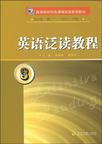英语泛读教程
出版时间:2009-8 出版社:苏州大学出版社 作者:胡金 等主编 页数:219
内容概要
根据教育部2006年颁布的《高等学校英语专业英语教学大纲》,我们编写了这套《英语泛读教程》系列教材,本教材适用于高等学校英语专业一、二年级泛读(阅读)课教学,也适用于同等程度的英语自学者。 本教材编写的目的在于传授学生有关的阅读理论与技巧,提升学生的英语阅读水平与理解能力,扩大词汇量,增加英语国家文化背景知识,为参加英语专业四、八级考试及其他形式英语考试奠定良好的基础。 本教材编写有如下几个主要特点。 第一,题材广泛,内容丰富,体裁多样。本系列教材的题材既关注了大学生活的有关方面,也涵盖了英语国家社会与文化的方方面面;既有人文知识方面的文献,也不乏科普常识方面的文章。教材选材注重时代感,集思想性、知识性、实用性和趣味性为一体,涉及历史、地理、政治、军事、法律、经济、科技、金融、宗教、体育、环保、能源、医药、食品、艺术、娱乐、休闲、旅游、风俗等各方面的内容。 第二,文章注重长度与难度的适切性,阅读量较适中。本系列教材的编写注重学习的规律性,所选文章由易到难,由浅入深,由短到长。而在阅读量的安排方面,遵循适中的原则,既不因太少而让学生感到吃不饱,也不因过量而使得学生产生厌烦情绪。文章长度从第1册的550至600词(每分钟阅读量为60词至80词)逐渐增加到第四册的1,500词左右(每分钟阅读量为180词)。 第三,读与写结合,读与说结合。每个单元的Text A与Text D部分除了安排阅读理解的练习之外,还适当地融入了写与说的训练,以期达到充分利用所学材料进行写与说等综合技能训练的目的。 第四,借助技巧指导阅读,通过实践强化理论。每册安排4个阅读技巧,每4个单元呈现1个阅读技巧,使得学生在理论与技巧的指导下进行实践。
书籍目录
Unit OnE Campus LifE Text A College Is Time to Budget Reading Skills Context Clues Word Study (1) Text B The Campus--Green, Greener, the Greenest Text C Yale Campus Just Part of New Haven's Vibrant Cultural Life Text D US College Sports, Clubs and Student Groups and Other Forms of Student LifeUnit Two LEarning English Text A Why Learn English Reading Skills Word Study(2) Text B How to Learn English Text C How to Avoid Making Mistakes in English Text D Teaching PhilosophyUnit ThrEE Books Text A Why Read? Reading Skills Word Study(3) Text B Books Are Among the Most Popular Activities Text C Five Types of Books That Increase Intelligence Text D About Reading Books Unit Four Friendship Text A On Friendship Reading Skills Word Study(4) Text B A Friend in Need Is a Friend Indeed Text C The Secrets of Male Friendships: Man Date Text D How to Be a Friend of YourselfUnit Five Hobbg Text A Cultivating a Hobby Reading Skills Word Study (5) Text B Developing Good Habits Text C Can You Change Your Habits? Text D The States ExplainedUnit Six Good MannErs Text A What Are Good Manners? Text B Teachers Got It Tough! Text C Where Has Common Courtesy Gone? Text D Excuse MeUnit SEVEN Food and Diet Text A Food Composition Proteins, Carbohydrates, Fats and Fibre Text B Food Composition Minerals and Vitamins Text C Food Properties Text D Food Acidity, Oxidation and TemperatureUnit Eight SafetyUnit Nine Sports and GamesUnit Ten HolidagsUnit Eleven Work and PlagUnit Twelve Feelings and LoveUnit Thirteen TravelsUnit Fourteen Modern LifeUNit Fitteen Successful PeopleUnit Sixteen Dreams
章节摘录
Yet there is a puzzle: why do we distinguish different senses, and what,exactly, are we distinguishing between? Answering these questions requires that wegive some account of what it is about our perceptions of things that makes themperceptions of one sense or another. Such an account needs to explain what makesthe Perceptions of different senses count as of different senses, and what theperceptions of a single sense have in common that makes them perceptions of asingle sense. If it can do that it will have answered the question of why we countexactly five senses (the counting question). The puzzle is that none of the obviouscandidate answers seems adequate. One such answer appeals to the sense organs. We distinguish different sensesbecause we perceive things with different parts of our body——with different senseorgans. The problem with this suggestion is that there are lots of different parts ofour body that are involved in perceiving——feet, hands, etc.——that we dont take tobe distinct senses. So why do we pick the parts we do? In response to this it might be suggested that sense organs arent just parts of thebody, they are different kinds of sensory mechanisms. That suggestion doesntwork. Consider touch. There are more than 15 functionally and morphologicallydistinct sensory mechanisms——sensitivity to temperature, pain, pressure, theposition of joints, and so on——which play a role in touch. We regard things that weperceive as a result of the operation of any or several of these distinct mechanisms asthings that we perceive by the sense of touch, so we cant simply identify the senseof touch with the operation of a kind of sensory mechanism. Something similar istrue of the other senses. One might react to this by saying that what this shows is that our everydaydistinction between five senses is mistaken. In fact there are many more than fivesenses and, therefore, the puzzle that I began with is misplaced. That conclusionwould follow only if it could be shown that our everyday distinction between fivesenses was a proto-scientific attempt to characterize the sensory mechanisms orprocesses involved in perception, and so subject to revision in the light of scientificdiscoveries. Many philosophers think that sense organs or sensory mechanisms——theunderlying physiology and psychological processes——are irrelevant to an explanationof our everyday distinction between the senses. This is because they think it isconceivable that someone who was congenitally blind could have their sightrestored artificially by being fitted with a prosthetic device.
图书封面
评论、评分、阅读与下载
用户评论 (总计0条)
推荐图书
- 聚集了作家的书,汇聚了不可能的书 книга, ради которой
- KERORO军曹Black:KERORO小队24小时篇
- 瀆神之主 01
- 瀆神之主 02
- 瀆神之主 03
- 最好的時光
- 神風怪盗ジャンヌ 完全版 01
- 神風怪盗ジャンヌ 完全版 02
- 神風怪盗ジャンヌ 完全版 03
- 神風怪盗ジャンヌ 完全版 04
- 神風怪盗ジャンヌ 完全版 05
- 饿死诗人
- 神風怪盗ジャンヌ 完全版 06
- かんしゃく玉のゆううつ
- 時空異邦人KYOKO 02
- 時空異邦人KYOKO 03
- 絶対覚醒天使ミストレス☆フォーチュン
- GOSICKII ―ゴシック?その罪は名もなき―
- 靈:萝魔
- 神風怪盗ジャンヌ 種村有菜イラスト集
- 中国哲学范畴发展史
- 神風怪盗ジャンヌ 01
- 神風怪盗ジャンヌ 02
- 神風怪盗ジャンヌ 03
- 神風怪盗ジャンヌ 04
